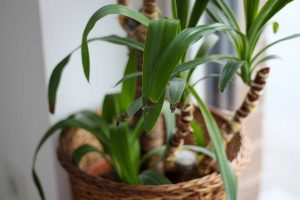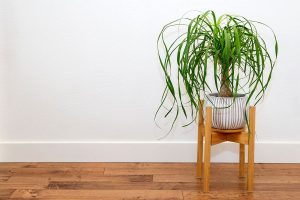Yucca Palms are a palm-like type of tree that actually belong to an entirely different family than palms. These trees are native to South America and parts of the Southern United States, and they can feature a central trunk or multiple trunks, with crowns of sword-shaped foliage bursting out like stars at the top.
They are popularly grown as ornamental specimens in the landscape and can also make great houseplants.
- Botanical name: Yucca sp.
- Common names: Yucca, Spineless Yucca, Spanish Dagger, Spanish Bayonet
- Plant family: Asparagaceae
- USDA hardiness zone: 5- 10
- Mature height: Up to 40 feet
- Mature spread: Up to 15 feet
Table of Contents
Varieties of Yucca Palm
There are over 40 different species of Yucca palm, many of which are popularly grown as houseplants. Some of the more widely known varieties of Yucca include:
Yucca filamentosa

This Yucca takes the shape of an evergreen shrub rather than a tree. It grows in clumps, producing dense mounds of foliage spreading out in a rosette pattern. The common names for this plant are Carolina Silk Grass and Adam’s Needle and Thread.
The foliage is bright green, and the plant produces white flowers which emerge in tall 6-foot panicles toward the end of summer.
Yucca aloifolia

This plant has many common names associated with its sharply pointed foliage, such as Spanish Bayonet, the Dagger Plant, and Needle Palm. The edges of the leaves are sharp and serrated, while the tips of the leaves are stiff and piercing.
The potentially harmful foliage of this plant makes it a poor choice as a houseplant, and it is also toxic to pets and other animals. It is exceptionally easy to grow since it is tolerant of drought, salt, and wind, and though it prefers full sun, it can also tolerate partial shade.
Yucca gigantea

This is the Yucca which is commonly known as the Stick Yucca or the Spineless Yucca. This is because the foliage of the plant is not sharp and potentially dangerous, like the Spanish Dagger Yucca. The Yucca gigantea is sometimes also botanically called Yucca elephantipes.
The name may give you some indication about its size; this plant typically grows to heights of between 25 and 40 feet when living in its natural habitat, but it will rarely exceed 5 feet when grown indoors as a houseplant. The Yucca gigantea features multiple trunks, and it can be grown as a tree or a large shrub. It is best suited to warm climates, growing outside in USDA hardiness zones 9 to 11.
How to Care for your Yucca Palm
Light

The level of light that is best for your Yucca Palm will be dependent on the type of Yucca species you have, but in general, most Yuccas enjoy bright levels of light. Yucca plants that are grown outside thrive in full sun, though in very hot climates, they can benefit from shade during the hottest part of the day.
For Yucca plants that are kept indoors as houseplants, bright indirect light works best. The leaves of the plant can get scorched in too much direct light, so position them several feet away from a bright window or behind sheer drapes.
Soil
In their natural habitat, Yucca plants grow in loose, sandy soils. Whether you are keeping your yucca in a pot or directly in the ground, you should aim to replicate this type of soil. This can be done by mixing sand and perlite into a regular potting mix or working sand into your existing garden soil.
A specific type of potting soil is unnecessary; as long as the soil drains well, then this will be appropriate for the Yucca. Yucca palms are susceptible to root rot, and they can easily be overwatered, which is why well-draining soil is essential.
Sandy soil mixes will drain quickly, ensuring any excess water drains down past the roots of the plant and out of the pot’s drainage holes, preventing the risk of root rot. Since Yucca palms are drought tolerant, they do not need soil that holds moisture against their roots, so organic matter does not need to be present in the soil mix.
Water
Yucca plants are drought-tolerant and extremely sensitive to excess moisture. You should make every effort not to overwater your Yucca because this is the easiest and quickest way to kill this type of plant. A well-draining soil is essential to making sure your Yucca does not get left in soggy conditions, but your watering schedule is also of equal importance.
Most Yucca plants will need to be watered around once a week through spring and summer, but this can change depending on the conditions your plant is growing in, so always be open to the possibility that once a week may be too frequent or too infrequent. Instead of following a specific schedule, listen to the specific needs of your Yucca.
Before watering your Yucca, you should check for moisture in the soil by dipping a finger into it. If the soil feels moist, then it is not yet time to water the plant. Wait for the soil to dry out between waterings to prevent overwatering. You could also lift the Yucca’s growing pot up and feel the bottom of the soil through the drainage holes.
If this is dry, you can go ahead and water the plant. In autumn and winter, the Yucca will need to be watered even less frequently, at a rate of around once or twice a month.
Temperature

Although Yucca palms are native to hot and dry climates, there are actually many species of Yucca that are cold hardy. If you are looking for a Yucca that will survive outside all year round, then you should be able to find one for almost any climate.
Most Yucca plants are suitable for growing in USDA hardiness zones 5- 10, but there are a few species that can withstand cooler regions, such as USDA hardiness zone 3, and hotter regions up to USDA hardiness zone 11.
The Soapweed yucca (Yucca glauca) is a particularly hardy variety of Yucca palm, which can adapt to temperatures as low as -35ºF. Hence it is one of the few species of palms that can tolerate freezing weather though it’s not recommended to do that. The Banana yucca (Yucca baccata) falls at the opposite end of the scale and is a type of Yucca that thrives in warmer climates. It can be grown through USDA hardiness zones 6 to 11.
Since Yucca plants fare well in warm conditions, they make good houseplants. They will thrive in the average room temperatures found in homes, and they can also tolerate dips in temperature, so they won’t react badly if set near a drafty window.
Humidity
Yucca palm plants are native to arid climates, so they do not need high levels of humidity. In fact, high humidity can be damaging to the plant, so don’t keep it near a humidifier or use a misting water spray on the foliage of the Yucca.
The fact that Yucca plants like low to average humidity makes them easy to care houseplants because you won’t need to go to any special efforts to increase humidity in the way that you would with many other houseplants.
Fertilizer
Fertilizer is not an essential part of Yucca care, but if you want to feed your plant, you can apply a diluted or weak liquid fertilizer once a month throughout the growing period. Avoid over-fertilizing as this can cause fertilizer burn on the roots, which will prevent the Yucca from absorbing moisture and nutrients.
Yucca Palm FAQs
How long does a Yucca Palm live for?
Yucca plants can actually be quite short-lived, especially when kept indoors. As a houseplant, it is not unusual for a Yucca to start to die back at around 5 years in age, though some species will surprise you and can live for many decades.
The process of dying back will begin with the lower leaves fading to brown and dropping from the tree, and this will then spread to the remaining crown of the plant. In their native habitat, some Yucca plants will live for in excess of 50 years, while those grown outside in non-native environments can live for several decades.
Are Yucca Palms easy to grow?
Yes, Yucca palms are incredibly easy to grow. They thrive on neglect, so they don’t require much attention at all. As long as they are placed in a sunny spot and have well-draining soil that is moistened every now and again, they will do very well. Yucca plants that are paid too much attention, especially with excessive watering, will have trunks that become spongy, and will die much sooner than anticipated.
Are Yucca Palms toxic?
Some Yucca palms, such as the Yucca aloifolia, are toxic to both pets and humans. However, there are varieties of Yucca which produce edible flowers and fruits. The Banana yucca (Yucca baccata) produces fruits that visually resemble bananas, and these can be baked and eaten in a similar way to sweet potatoes. The fruit has a high sugar content which means they also work well in desserts such as pies.
Why Are My Yucca Palm’s Leaves Turning Yellow?
Yellow leaves on a yucca palm can be attributed to several factors. One common cause is waterlogging or excessive humidity. Yuccas are native to dry climates and require well-draining soil. Overwatering or planting in poorly draining soil may lead to root rot, causing the leaves to turn yellow.
Another factor could be insufficient light. Yucca palms thrive in bright, indirect light and can suffer from yellowing leaves when they don’t receive enough sunlight. Also, sunburn may lead to discoloration if the plant is exposed to direct sunlight for extended periods.
Finally, you might expect your yucca palm or any palm tree’s leaves to turn yellow, as it is a natural process when the plant grows and sheds older foliage.






